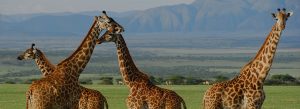Preservation Targets in Ngorongoro Crater: Key Species
The Ngorongoro Crater, located in Tanzania, is a UNESCO World Heritage Site and one of the most iconic conservation areas in Africa. It is home to a diverse range of wildlife species, making it a vital area for preservation efforts. Conservation targets play a crucial role in maintaining the delicate balance of ecosystems within the crater. In this article, we will discuss the importance of conservation targets in Ngorongoro Crater and highlight some key species that are essential for preservation.
Importance of Conservation Targets in Ngorongoro Crater
Conservation targets are specific species or ecosystems that are identified for protection and preservation within a conservation area. In the case of Ngorongoro Crater, these targets are crucial for maintaining the biodiversity and ecological balance of the area. By focusing on key species and habitats, conservation efforts can help ensure the long-term sustainability of the ecosystem and protect endangered species from extinction.
Preserving conservation targets in Ngorongoro Crater also has wider benefits for the surrounding communities and the ecosystem as a whole. The crater is a major tourist attraction, drawing visitors from around the world to witness the incredible wildlife and natural beauty of the area. By protecting key species and habitats, conservation efforts help support the local economy through tourism and promote the importance of conservation to visitors.
Essential Key Species for Preservation in the Crater
-
Lions: The Ngorongoro Crater is home to a significant population of lions, making them one of the key species for preservation in the area. Lions play a crucial role in maintaining the balance of the ecosystem by controlling the population of herbivores such as wildebeest and zebra. Conservation efforts focus on protecting lions from poaching and habitat destruction to ensure their continued presence in the crater.
-
Black Rhinos: The Ngorongoro Crater is one of the last strongholds for the endangered black rhino in Tanzania. Conservation targets prioritize the protection of these iconic animals, as their population has been severely impacted by poaching and habitat loss. Efforts to monitor and protect black rhinos in the crater have been successful in increasing their numbers in recent years.
-
Elephants: Elephants are another key species for preservation in Ngorongoro Crater. These majestic animals play a vital role in shaping the landscape through their feeding habits and seed dispersal. Conservation efforts focus on reducing human-wildlife conflict and protecting elephant habitats to ensure their long-term survival in the area.
-
Cheetahs: The Ngorongoro Crater is known for its high population of cheetahs, the fastest land animals in the world. Conservation targets aim to protect these vulnerable predators from threats such as habitat fragmentation and competition with other carnivores. Monitoring and research efforts help track cheetah populations and ensure their conservation in the crater.
In conclusion, conservation targets in Ngorongoro Crater are essential for maintaining the delicate balance of ecosystems and protecting key species from extinction. By focusing on key species such as lions, black rhinos, elephants, and cheetahs, conservation efforts help ensure the long-term sustainability of the area. To experience the incredible wildlife of Ngorongoro Crater, book a safari tour with Sunset Africa Safari by contacting info@sunsetafricasafari.com.


